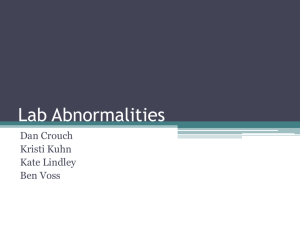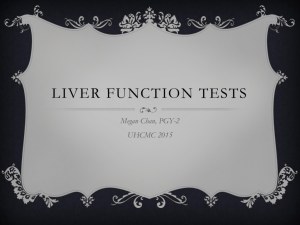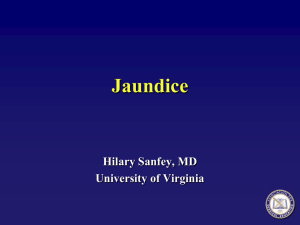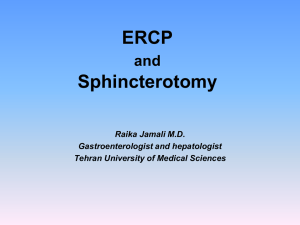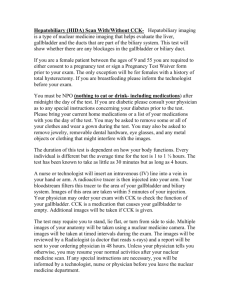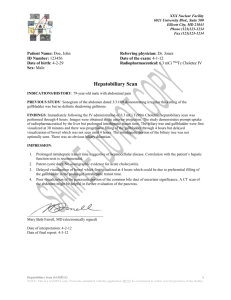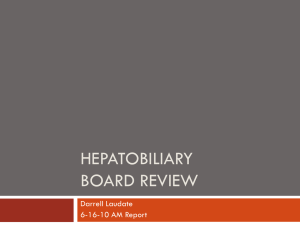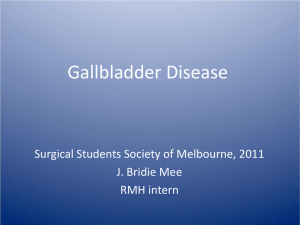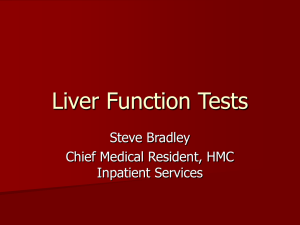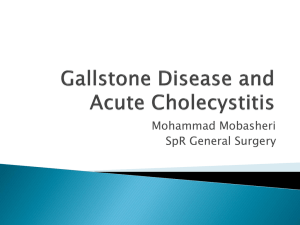LFTS Part 1 Biliary
advertisement
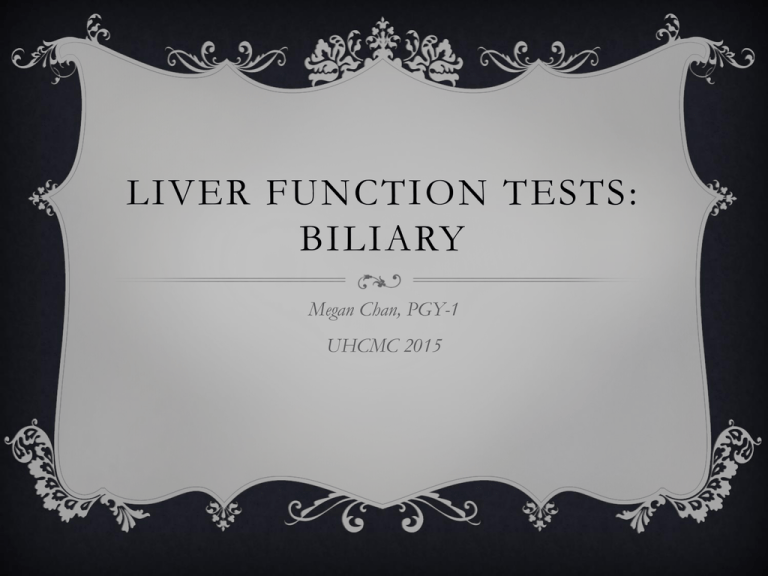
LIVER FUNCTION TESTS: BILIARY Megan Chan, PGY-1 UHCMC 2015 GUESS THE LFTS CHOLELITHIASIS If Asymptomatic: If Pass a Stone: AST AST • Normal ALT • Normal Alk Phos • Normal T bili • Normal • Elevated ALT • Elevated Alk Phos • Elevated T bili • Normal http://radiopaedia.org/articles/cholelithiasis ACUTE CHOLECYSTITIS AST • Normal ALT • Normal http://radiopae dia.org/images/ 1780983 Alk Phos • Elevated T bili • Normal http://radiopaedia.or g/cases/acutecholecystitis-4 CHOLEDOCHOLITHIASIS AST • Normal Elevated ALT • Normal Elevated Alk Phos • Elevated T bili • Elevated http://radiopaedia.org/articles/choledocholithiasis PRACTICE CASES CASE 1 46 y/o female presents with intermittent RUQ pain and heartburn to your clinic. Vitals are stable and exam is unremarkable. CT abdomen from an OSH is shown on the right. What is the diagnosis? http://radiopaedia.org/articles/cholelithiasis CASE 1 46 y/o female presents with intermittent RUQ pain and heartburn to your clinic. Vitals are stable and exam is unremarkable. CT abdomen from on OSH is shown on the right. What is the diagnosis? Cholelithiasis http://radiopaedia.org/articles/cholelithiasis CHOLELITHIASIS Gallstones or sludge in the gallbladder ~10% population, symptomatic in only 25% of cases 3 types of stones: • Cholesterol stones—associated with obesity, DM, HLD, OCP use, multiple pregnancies, advanced age, Crohn’s disease, ileal resection, cirrhosis, CF • Pigment stones • • Black stones—hemolysis, alcoholic cirrhosis Brown stones—biliary tract infection • Mixed stones = 80% Pathophysiology: • Cholesterol supersaturation from reduced bile secretion (age, TI disease, liver dz) or hypersecretion of cholesterol (e.g. estrogen, obesity liver dz) • Crystal nucleation • Gallbladder hypomotility (e.g. pregnancy, prolonged TPN, somatostatin) • Other: Decreased bile transit time, bacteria presence CHOLELITHIASIS Clinical features: • Biliary colic, esp after eating & at night, lasts 30 min to 3 hrs • Boas’ sign = referred right subscapular pain of biliary colic Diagnosis: RUQ ultrasound has sensitivity and specificity > 95% for stones > 2mm, best if fasting ≥ 8 hrs Tx: Elective cholecystectomy for pts with recurrent biliary colic DDx: Gallbladder polyp/carcinoma CASE 2 55 y/o male with PMHx of recurrent pancreatitis presents to the ED with RUQ abdominal pain and vomiting. Pt is found to be febrile and hypotensive. IV fluids are initiated and the following labs are obtained: WBC 13,000, AST 25, ALT 30, Alk Phos 450, T bili 1.0, Lipase 20 What is the most likely diagnosis and what is the next best diagnostic step? CASE 2 55 y/o male with PMHx of recurrent pancreatitis presents to the ED with RUQ abdominal pain and vomiting. Pt is found to be febrile and hypotensive. IV fluids are initiated and the following labs are obtained: WBC 13,000, AST 25, ALT 30, Alk Phos 450, T bili 1.0, Lipase 20 What is the most likely diagnosis and what is the next best diagnostic step? Acute Cholecystitis, RUQ ultrasound ACUTE CHOLECYSTITIS Inflammation of gallbladder 2/2 obstruction of cystic duct Develops in 10% of those with cholelithiasis Clinical features: • RUQ tenderness >4-6 hrs ± rebound • Murphy’s sign = inspiratory arrest during deep palpation of RUQ • Low grade fever, leukocytosis, nausea, vomiting, hypoactive bs ACUTE CHOLECYSTITIS Diagnosis: • US is test of choice • Distended gallbladder with thickened wall > 5mm, pericholecystic fluid, ± stones • HIDA radionuclide scan if US inconclusive • If gallbladder not visualized 4 hours after injection, diagnosis is confirmed.(97% sensitive, 96% specific) Treatment: • Supportive: IV fluids, NPO, IV abx (Zosyn, Unasyn, 3rd gen cephalasporin + Flagyl), analgesics, electrolyte replacement • Semiurgent Cholecystectomy w/in 72 hrs to avoid gangrenous/emphysematous cholecystitis http://www.stritch.luc.edu/l umen/MedEd/Radio/curric ulum/Procedures/HIDA_sc an1.htm CASE 3 52 y/o male transferred from an OSH for intermittent abdominal pain and progressive jaundice over the past 2 days. Further history reveals symptoms consistent with biliary colic. Exam shows a patient in mild distress with tenderness in the RUQ and jaundice. Labs are significant for: AST 450, ALT 520, Alk Phos 630, T Bili 4.2 What is the most likely diagnosis and what is your next step in management? CASE 3 52 y/o male transferred from an OSH for intermittent abdominal pain and progressive jaundice over the past 2 days. Further history reveals symptoms consistent with biliary colic. Exam shows a patient in mild distress with tenderness in the RUQ and jaundice. Labs are significant for: AST 450, ALT 520, Alk Phos 630, T Bili 4.2 What is the most likely diagnosis and what is your next step in management? Choledocholithiasis, ERCP—diagnostic and therapeutic CHOLEDOCHOLITHIASIS Gallstones within the common bile duct or common hepatic duct, formed in situ or passed from gallbladder Presentation: asymptomatic (~50%) biliary colic ascending cholangitis, obstructive jaundice, acute pancreatitis Definitions of dilated bile duct • >6mm + 1mm per decade above 60 y/o • >10 post-cholecystectomy • Dilated intrahepatic biliary tree CHOLEDOCHOLITHIASIS Diagnostic studies: • Transabdominal US 13-55% sensitivity1, Endoscopic US higher sensitivity and specificity for intraductal stones • CT w/ contrast 65-88% sensitive2, CT cholangiography 93% sensitive, 100% specific but difficult to perform3 • MRCP and ERCP both have sensitivities and specificities approaching 100%4 Treatment: • ERCP with sphincterotomy, stone extraction, stent placement • Successful in 90% of patients • Complication rates 6-24%5, including pancreatitis DDx: cholangiocarcinoma, pancreatic adenocarcinoma CHOLEDOCHOLITHIASIS ERCP MRCP http://radiopaedia.org/images/2413474 http://www.jcdr.net/article_fulltext.asp?issn=0973709x&year=2013&volume=7&issue=9&page=1941&issn=0973709x&id=3365 CASE 4 50 y/o female admitted to the MICU for AMS. Vitals include temp 39, HR 110, BP 90/60, RR 20, sat 96% on RA. Exam reveals a somnolent female with jaundice, scleral icterus, and guarding upon palpation of the RUQ. Labs reveal: WBC 16,000, AST 160, ALT 200, Alk Phos 650, T bili 8.0. Blood cultures are pending. What is the most likely diagnosis? CASE 4 50 y/o female admitted to the MICU for AMS. Vitals include temp 39, HR 110, BP 90/60, RR 20, sat 96% on RA. Exam reveals a somnolent female with jaundice, scleral icterus, and guarding upon palpation of the RUQ. Labs reveal: WBC 16,000, AST 160, ALT 200, Alk Phos 650, T bili 8.0. Blood cultures are pending. What is the most likely diagnosis? Septic shock 2/2 Acute Cholangitis CHOLANGITIS Infection of biliary tract 2/2 obstruction biliary stasis & bacterial overgrowth • Ecoli & Klebsiella 70%, Enterococcus & Anaerobes (15%) Choledocholithiasis accounts for 60% of cases Other causes: pancreatic/biliary neoplasm, strictures, s/p ERCP, choledochal cysts Clinical features: • Charcot’s Triad: RUQ pain + Jaundice + Fever • Present in 60-79% • Reynolds’ Pentad: Charcot’s triad + Septic shock + AMS • Present in ~15% • Medical emergency if fever >40ºC, septic shock, peritoneal signs, or bilirubin > 10 CHOLANGITIS Diagnosis/Treatment: • IV abx (Zosyn, Unasyn, 3rd gen cephalasporin), IV fluids • RUQ ultrasound as initial study • When pt stable and afebrile for 48 hrs perform either: • PTC (percutaneous transhepatic cholangiography) decompression via catheter placement • ERCP sphincterotomy • T-tube insertion via laparotomy • May need emergent procedures if pt doesn’t respond to IV abx (~15%) SUMMARY Cholelithiasis Cholecystitis Choledocholithiasis Cholangitis Stones in gallbladder Obstruction of cystic duct Inflammation Gallstones in CBD Infection of biliary tract Biliary colic Murphy’s sign Fever, ↑ WBC Biliary colic, jaundice Charcot’s triad CASE 5 You are asked to consult on a 62 y/o Caucasian female with pruritis for 4 months. She has also noticed progressive fatigue and a 5-lb wt loss. She has intermittent nausea but no vomiting & denies changes in her bowel habits. She denies any history of alcohol use, blood transfusions or illicit drugs. She is widowed and had 2 heterosexual partners in her lifetime. PMHx if significant only for hypothyroidism, for which she takes levothyroxine. Her mother has Sjogren’s but there is no family hx of liver disease. On exam, she is mildly icteric, has spider angiomata on her torso, and the following skin findings: CASE 5: EXAM What is this? http://www.hxbenefit.com/wpcontent/uploads/2011/12/Xanthe lasma.jpg CASE 5: EXAM Xanthelasma http://www.hxbenefit.com/wpcontent/uploads/2011/12/Xanthe lasma.jpg CASE 5 CONT Furthermore, you palpate a nodular liver edge 2cm below the right costal margin. The remainder of the exam is unremarkable. A RUQ ultrasound confirms your suspicion of cirrhosis. CBC and CMP are pending. What is the most appropriate next step? A. 24-h urine copper B. Antimitochondrial antibioties (AMA) C. ERCP D. Hepatitis B serologies E. Serum ferritin CASE 5 What is the most appropriate next step? A. 24-h urine copper B. Antimitochondrial antibioties (AMA) C. ERCP D. Hepatitis B serologies E. Serum ferritin The presence of cirrhosis in an elderly woman with no prior risk factors for viral or alcoholic cirrhosis should raise the possibility of primary biliary cirrhosis (PBC). AMA is + in 95% with low false positives. Liver biopsy showing chronic inflammation and fibrous obliteration of intrahepatic ducts can confirm the diagnosis. PRIMARY BILIARY CIRRHOSIS Autoimmune destruction of intrahepatic bile ducts Associated with other autoimmune dz & often presents with fatigue and pruritus Clinical jaundice when total bilirubin >2 mg/dL Labs: • Increased alk phos, bilirubin, and cholesterol (but no ↑ risk for CAD) • + antimitochondrial Ab (AMA) in 95% Tx: • Ursodeoxycholic acid (13-15 mg/kg/d)—reduces the overall toxicity of bile salt pool, ↑ survival • Cholestyramine for puritis--↓ serum bile levels by binding & preventing gut absorption • Fat soluble vitamins: Vit A, E, D, K • Screen for osteoporosis (independent risk factor for Vit D deficiency) • Liver transplant: ~20% recur • However without liver transplant, medial survival is 10-12 yrs after dx CASE 6 24 y/o patient is admitted to the MICU with obtundation and jaundice over 1-2 days. No further history is available. The following labs are obtained: Total Bili 7.2, Direct Bili 4.0, AST 1478, ALT 1056, Alk Phos 132, INR 3.1, Albumin 3.6. All of the following tests are indicated except? A. Antinuclear Ab (ANA) B. Ceruloplasmin C. Hepatitis B surface Ag D. ERCP E. Toxicology screen CASE 6 All of the following tests are indicated except? A. Antinuclear Ab (ANA) B. Ceruloplasmin C. Hepatitis B surface Ag D. ERCP E. Toxicology screen When evaluating a patient with jaundice, initial steps include determining whether the hyperbilirubinemia is predominantly unconjugated or conjugated and whether there is any other evidence for hepatobiliary dysfxn. Next is to discriminate into a predominantly cholestatic or hepatocellular pattern. In this case, the pt has a hepatocellular pattern with AST/ALT elevated out of proportion to Alk Phos. Harrison’s Internal Medicine CASE 7 41 y/o male who presents to your clinic with a week of jaundice. He notes pruritus, icterus, and dark urine. He denies fever or abdominal pain. Exam is unremarkable except for jaundice. Labs: Total bili 6.0 , direct bili 5.1, AST 84 , ALT 92, Alk phos 662. CT scan of abdomen is unremarkable. RUQ ultrasound shows a normal bile duct but does not visualize the common bile duct. What is the most appropriate next management step? A. Antibiotics and observation B. ERCP C. Hepatic serologies D. HIDA scan E. Serologies for antimitochondrial Ab CASE 7 What is the most appropriate next management step? A. Antibiotics and observation B. ERCP C. Hepatic serologies D. HIDA scan E. Serologies for antimitochondrial Ab Anatomic abnormalities are more common when there is a cholestatic pattern of injury (Alk Phos elevated out of proportion to AST/ALT). Painless jaundice always requires extensive workup with concern for malignant causes (e.g. cholangiocarcinoma, tumor of ampulla of vater) vs nonmalignant causes (e.g. primary sclerosing cholangitis), which may only be detected by direct visualization with ERCP. Negative CT does not rule out source of cholestatis in biliary tree. Furthermore, ERCP is useful therapeutically with stenting to alleviate the obstruction. Harrison’s Internal Medicine CASE 8 44 y/o woman is evaluated for complaints of abdominal pain. She describes the pain as postprandial burning pain. It is worse with spicy or fatty foods and is relieved with antacids. She is diagnosed with a gastric ulcer and treated appropriately for H. pylori. Following treatment of H. pylori, her symptoms have resolved. During the course of her evaluation for her abdominal pain, the patient has a RUQ ultrasound that demonstrates the presence of numerous gallstones, including in the neck of the gallbladder. The largest stone measures 2.8cm. She is requesting your opinion regarding whether treatment is required for her gallstone disease. CASE 8 What is your advice to the patient regarding the risk of complications and the need for definitive treatment? A. Given the size and number of stones, prophylactic cholecystectomy is recommended. B. No treatment is necessary unless the patient develops symptoms of biliary colic frequently and severely enough to interfere with the patient’s life. C. The only reason to proceed with cholecystectomy is the development of gallstone pancreatitis or cholangitis. D. The risk of developing acute cholecystitis is about 5-10% per year. E. Ursodeoxycholic acid should be given at a dose of 10-15 mg/kg for a minimum of 6 months to dissolve the stones. CASE 8 What is your advice to the patient regarding the risk of complications and the need for definitive treatment? A. Given the size and number of stones, prophylactic cholecystectomy is recommended. B. No treatment is necessary unless the patient develops symptoms of biliary colic frequently and severely enough to interfere with the patient’s life. C. The only reason to proceed with cholecystectomy is the development of gallstone pancreatitis or cholangitis. D. The risk of developing acute cholecystitis is about 5-10% per year. E. Ursodeoxycholic acid should be given at a dose of 10-15 mg/kg for a minimum of 6 months to dissolve the stones. Only 1-2 % of patients with asymptomatic gallstone disease will develop compliations that will require surgery yearly. 4 factors should be considered in evaluation for surgery: 1) Symptoms that are severe and frequent enough to necessitate surgery. 2) Hx of prior complications of gallstone disease (e..g pancreatitis, acute cholecystitis) 3) Presence of anatomic factors that increase the likelihood of complications (e.g. porcelain gallbladder, congenital biliary tract abnormalities) 4) Large stones >3cm Ursodeoxycholic acid can be used in some instances to dissolve gallstones. It acts to decrease the cholesterol saturation of bile & allows the dispersion of cholesterol from stones. It is only effective, however, for radiolucent stones <10mm. CASE 9 62 y/o man has been in the ICU for the past 3 weeks following an automobile accident results in multiple long-bone fractures and ARDS. He has been slowly improving, but remains on mechanical ventilation. He is now febrile & hypotensive, requiring vasopressors. He is being treated empirically with cefepime and vancomycin. Multiple blood cultures are negative. He has no new infiltrates on CXR. Labs show a risk in AST, ALT, bilirubin, and alk phos. Amylase and lipase are normal. A RUQ ultraound shows sludge in the gallbladder, but no stones. The bile duct is not dilated. What is the next best step in the evaluation and treatment of this patient? A. Discontinue cefepime B. Initiate clindamycin C. Initiate metronidazole D. Perform hepatobiliary scintigraphy (HIDA) E. Refer for exploratory laparotomy CASE 9 What is the next best step in the evaluation and treatment of this patient? A. Discontinue cefepime B. Initiate clindamycin C. Initiate metronidazole D. Perform hepatobiliary scintigraphy (HIDA) E. Refer for exploratory laparotomy Have a high index of suspicion for acalculous cholecystitis in critically ill patients who develop decompensation during the course of treatment with no other apparent source of infection. Some predisposing conditions include serious trauma or burns, postpartum after prolonged labor, prolonged parenteral hyperalmentation, post op after orthopedic or major surgery. US and CT scan typically only show biliary sludge, but may demonstrate large/tense gallbladder. HIDA often showed delayed or absent gallbladder emptying. In critically ill pts, a percutaneous cholecytostomy may be the safest immediate procedure to decompress an infected gallbladder. Once the pt is stabilized, early elective cholecystectomy should be considered. Metronidazole to cover anaerobes should be added, but would not elucidate the underlying condition. REFERENCES Adamek HE, Albert J, Weitz M et-al. A prospective evaluation of magnetic resonance cholangiopancreatography in patients with suspected bile duct obstruction. Gut. 1998;43 (5): 680-3. Agabegi SS, Agabegi ED. Step –Up to Medicine, 3rd ed. 2013. Lippincott Williams & Wilkins. Philadelphia, PA. Caoili EM, Paulson EK, Heyneman LE et-al. Helical CT cholangiography with three-dimensional volume rendering using an oral biliary contrast agent: feasibility of a novel technique. AJR Am J Roentgenol. 2000;174 (2): 487-92. Cronan JJ. US diagnosis of choledocholithiasis: a reappraisal. Radiology. 1986;161 (1): 133-4. Guardino JM. Primo Gastro. 2008. Lippincott Williams & Wilkins. Philadelphia, PA. Miller FH, Hwang CM, Gabriel H et-al. Contrast-enhanced helical CT of choledocholithiasis. AJR Am J Roentgenol. 2003;181 (1): 125-30. Sabatine, MS. Pocket Medicine, 4th ed. 2011. Lippincott Williams & Wilkins. Philadelphia, PA. Sugiyama M, Suzuki Y, Abe N et-al. Endoscopic retreatment of recurrent choledocholithiasis after sphincterotomy. Gut. 2004;53 (12): 1856-9. Wiener C, Fauci AS, Braunwald E, et al. Harrison’s Principles of Internal Medicine Self-Assessment & Board Review, 17th ed. 2008. McGraw Hill. New York, NY. http://medicine.ucsf.edu/education/resed/Chiefs_cover_sheets/SBP,%20cirrhosis,%20empyema.pdf http://radiopaedia.org Special thanks to Dr. Caroline Soyka for the inspiration!
